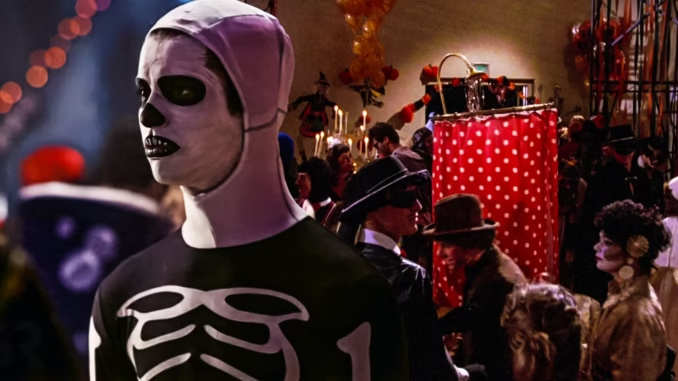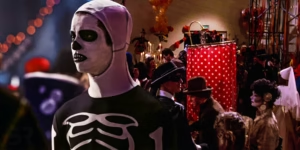




Introduction
I make no excuses for my love of the Karate Kid movies and the spin off tv show Cobra Kia. I can watch them during any holiday, even Halloween, and found a connection my life. I acknowledge that Halloween may not be the first lens through which we view martial arts, but sometimes the most unexpected symbols carry the deepest lessons. In The Karate Kid and its spin off series, Cobra Kai, the image of a skeleton costume – a playful, seasonal costume – becomes a quiet bridge across generations of martial artists.
Movie/TV Context
In the original Karate Kid (1984), a young Johnny Lawrence, played by William Zabka, appears in a skeleton costume for Halloween. Decades later, in Cobra Kai (2018), his student Miguel Diaz, played by Xolo Maridueña, dons the same skeletal costume. On the surface, this is a nod to tradition and nostalgia. However, for those familiar with martial arts, it can carry a more profound significance.
Martial Arts Focus
Martial arts is often about lineage. As a practitioner of Chinese martial arts, I was taught to honor my teachers, to remember the principles of my style, and to respect the struggles of those who came before me. To me, the skeleton costume becomes more than a Halloween gimmick; it is a subtle visual metaphor for that lineage. The character Johnny Lawrence did not practice a Chinese martial art, he learned Cobra Kai Karate, which is inspired by Tang Soo Do. That said, the importance of lineage within the Karate Kid/Cobra Kai story lines are still important. Just as Miguel stands in Johnny’s shoes, learning lessons that Johnny once learned himself, he also carries forward the memory of those who trained before him.
Spiritual and Cultural Reflection
In many cultures, including those that observe All Saints Day and the Day of the Dead, skeleton imagery serves as a reminder of our connection to those who came before us. Martial artists, particularly in traditional styles, are taught to honor their ancestors and predecessors. This is not merely a ritual, but is a grounding in humility, respect, and continuity. Halloween’s playful skeleton masks can, in this light, serve a similar purpose. They can serve as reminder that even as we train, fight, or perform, we do so as part of a long lineage.
The Link Between Johnny and Miguel
When Johnny wore the skeleton costume as a child, he was unknowingly participating in a symbolic gesture that would resonate years later through Miguel. The show’s creative decision to mirror that imagery is more than nostalgia; it is a visual teaching about mentorship, legacy, and the continuity of martial arts values. Just as Miguel internalizes Johnny’s teachings, so too does the costume remind viewers that every student is part of a living chain of martial knowledge. I will not include spoilers, but I will say that life unfolded slightly different for Johnny when he work the skeleton costume than it did for Miguel. That, too, is an important less that is imparted across generations.
Closing Reflection
In martial arts, the lessons we inherit are not only physical but spiritual. Halloween, All Saints Day, and the Day of the Dead all invite us to remember the dead, not in fear, but in gratitude. As martial artists, we can see in Johnny and Miguel’s skeletons as a playful yet powerful metaphor: training is never just about the present; it is about honoring the past and carrying its lessons forward.
Next Halloween, as masks and costumes abound, consider the unseen skeletons in your own training – teachers, mentors, and ancestors. Maybe even fictional role models such as Mr. Miyagi or Johnny Lawrence. Each of them reminds us that martial arts is not just a skill, but a lineage. It is a story and sacred connection across time.
- Yuen Woo-Ping: Shaping Narratives One Sword Stroke at a Time - December 11, 2025
- Bob Anderson: Modern Day Sword Master - November 24, 2025
- Skeletons, Students, and Spirits: Halloween Lessons in The Karate Kid and Cobra Kai - October 29, 2025

Leave a Reply